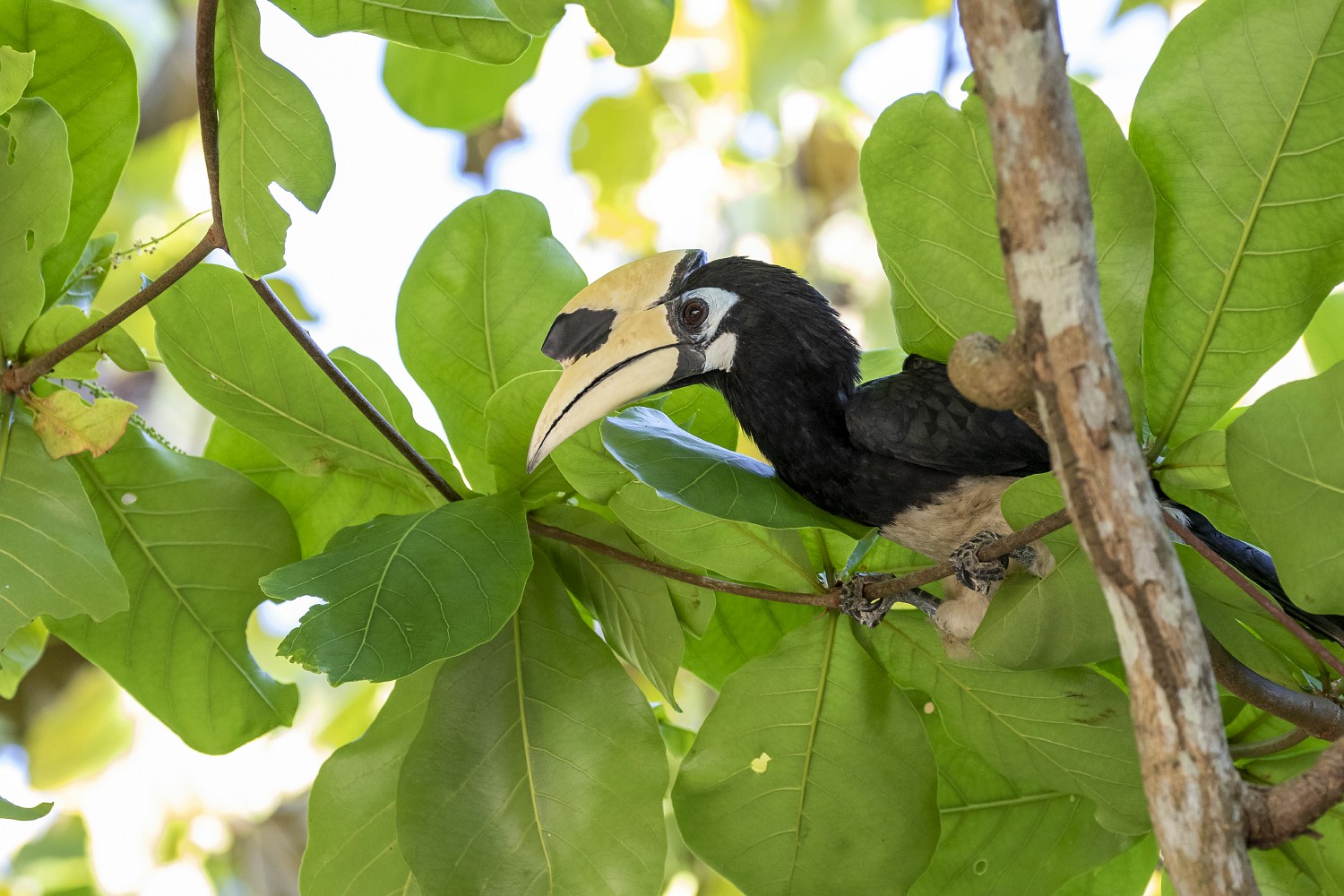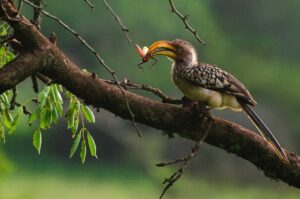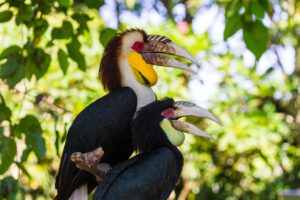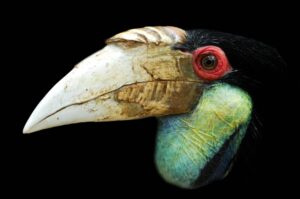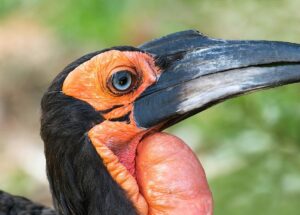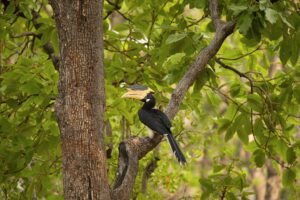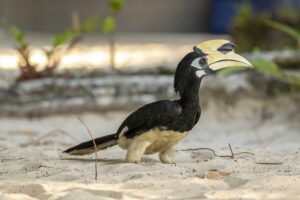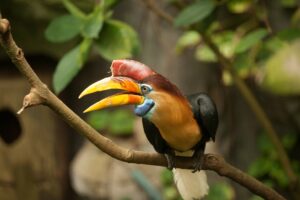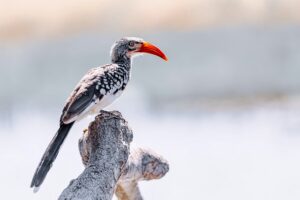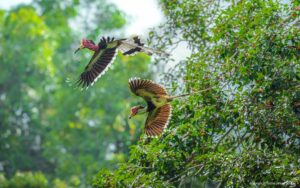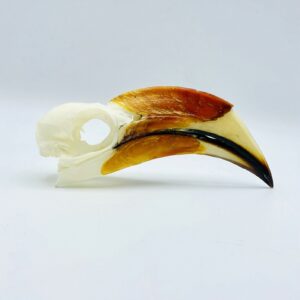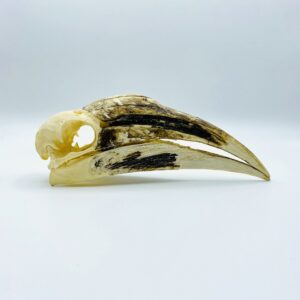The hornbill is a unique tropical bird belonging to the family Bucerotidae. But do not mistake it for a parrot. Larger than most other forest birds, a hornbill has a flashy appearance with an oversized and brightly-colored beak, long eyelashes (which are actually feathers), and a patch of bright coloration around the eyes and throat. Some even have a dazzlingly colored pouch of sagging skin at the throat for carrying food.
The speciality of a hornbill is that they have a casque, a hollow structure on the upper mandible of their down-curved bill which looks like a horn, and hence the name ‘hornbill.’ In some hornbill species the casque isn’t hollow but is packed with hornbill ivory. There are approximately 60 species of hornbills, and while it is not feasible to name them all, some of the prominent ones are the southern ground hornbill (Bucorvus leadbeateri), great hornbill (Buceros bicornis), northern ground hornbill (Bucorvus abyssinicus), red-billed hornbill, rhinoceros hornbill, black-and-white-casqued hornbill, southern yellow-billed hornbill, and more.
Primarily distributed in the Indian subcontinent, sub-Saharan Africa, the Solomon Islands, and the Philippines, the hornbill is a distinctive bird of the tropical wildlife. Read on to learn more interesting facts about the hornbill.
Hornbill Interesting Facts
What type of animal is a hornbill?
A hornbill is a bird belonging to family Bucerotidae. There are several species of hornbills, the most well-known ones being the southern ground hornbills, the northern ground hornbills, and the great hornbill.
What class of animal does a hornbill belong to?
Belonging to class Aves, the hornbill is a bird with a large bill (beak) and distinctive colors on the body.
How many hornbill are there in the world?
While the exact figures are unknown, the International Union for Conservation of Nature notes that an overwhelming number of hornbill species are not vulnerable to extinction. However, deforestation and overhunting is causing a rapid decline in population of several species.
Where does a hornbill live?
Different species of hornbills are mostly found in the savannahs, grasslands, and tropical forests.
What is a hornbill’s habitat?
Hornbills are brilliantly beautiful creatures with a distribution across the tropical regions of Africa and Asia. Distinct species are endemic to specific geographical regions with unique behavior and ecology. For instance, the great hornbill (Buceros bicornis) is found in the Malay peninsula, Indonesia, and mainland Southeast Asia, the southern ground hornbills (Buceros leadbeateri) are restricted to the savannahs of sub-Saharan Africa, and the northern ground hornbills (Buceros abyssinicus) are found across a wide region in Northcentral Africa. Most hornbills dwell in forests and are found nesting in the hole of trees. Species that dwell in open habitats are the ones nesting in the cavities of hollow forest trees or in the hole of cliffs. You can also find hornbills in a zoo in many parts of the world.
Who do hornbill live with?
Hornbills tend to stick with their families. The number of individuals in a flock varies with the species and can range from a few family members to hundreds of individuals. Hornbills like to keep a close watch on their chicks. Some hornbills often associate with other animal species. For instance, African hornbills have a mutual relationship with dwarf mongooses, they forage around together for food and warn each other of nearby predators. Other commensal relationships include that with monkeys whereby they follow the monkeys and feed on the insects flushed up by the latter.
How long does a hornbill live?
The average lifespan of hornbills ranges from 35-40 years but some have a life expectancy of up to 50 years in captivity.
How do they reproduce?
The breeding biology of hornbills is quite remarkable. They usually form monogamous (one mate at a time) pairs but some species also exhibit cooperative breeding (chicks receive care from parents as well as other members). During the breeding season, the females are sealed inside the nesting chambers which are usually holes and crevices in rocks and trees. The females lay up to seven eggs (smaller species) and one to two eggs (larger species). An astonishing aspect of this breeding process is that the male assists in closing the entrance of the nest cavity with a wall of droppings, mud, or fruit pulp, and once the females enter the cavity for laying eggs and subsequent incubation, the opening is sealed shut. This unique mechanism protects the females and the chicks from predators. The male birds help in feeding the female and the chicks and once the young hornbills are partially grown, the females break out from the nest and the cavity is re-walled. Depending on the species, the incubation period can range from 23 to 96 days.
What is their conservation status?
According to the International Union for Conservation of Nature (IUCN) Red List, the helmeted hornbill is Critically Endangered due to the trading of its hornbill ivory-filled casque. The great hornbill is Near Threatened due to rampant habitat destruction and the southern ground hornbill has the IUCN conservation status of Vulnerable, meaning that they may be on the verge of extinction in the future due to their relatively limited distribution. Others species of hornbills around the world including the northern ground hornbills and black-and-white-casqued hornbills are not globally threatened but their populations are on a rapid decline due to deforestation.
Hornbill Fun Facts
What do hornbill look like?
What gives hornbills a distinctive look is their unique downward curving bill (beak) and colored areas on the face, bill, neck, and casque. On the upper part of the beak sits a casque, a hollow structure made of keratin. Even though some species like the rhinoceros hornbills and the black-casqued hornbills have an enormous and elaborate casque, their exact function is not known. The casques are mostly filled with air cavities. But the helmeted hornbill found in Southeast Asia is an exception because its casque is solid and filled with hornbill ivory. Hornbills have a long tail, broad wings, and a thin neck. In most species, the feathers are grey, black or brown with bold markings in white. A distinguishing feature of the southern ground hornbill is the presence of a red inflatable throat sac below the neck.
How cute are they?
Hornbills aren’t typically regarded as “cute.” But these tree-dwelling creatures indeed look beautiful and imposing with their quirky physical features.
How do they communicate?
Hornbills have different kinds of calls for communication that range from deep booms to toots, cackles, bellows, and brays. It is theorized that the casque on the bill of these birds acts as a vibrating chamber to make their voice more powerful.
How big is a hornbill?
The largest species of hornbill, the southern ground hornbill, has an average length of 39.37 in (100 cm) and a wingspan ranging between 3.94-5.91 ft (1.2-1.8 m). It is over three times as large as the smallest species, which is the red-billed dwarf hornbill with an average size of 12 in (30 cm).
How fast can a hornbill fly?
While information for all species of hornbills is not available, the southern ground hornbill is known to fly up to 18 mph.
How much does a hornbill weigh?
The largest hornbill is the southern ground hornbill that weighs between 4.85-9.25 lb (2.2-4.2 kg). In comparison, the smallest ones, the red-billed dwarf hornbill weigh around 0.18- 0.25 lb (84 g – 115 g).
What are their male and female names of the species?
A male hornbill and a female hornbill do not have any distinct names.
What would you call a baby Hornbill?
Like most other birds, a baby hornbill is called a chick.
What do they eat?
Hornbills are primarily omnivorous but fruit forms a major part of their food. They are known to be opportunistic predators and will prey on insects and small animals (including birds, reptiles, and mammals). Some even feed on poisonous animals such as scorpions and snakes.
Are they dangerous?
Even with their imposing beak, hornbills are not known to be dangerous, at least to humans. Rather, they flee when disturbed.
Did you know…
- Hornbills have fused vertebrae in the neck and strong muscles to support the weight of their bills and casque.
- Southern ground hornbills make such loud booming sounds that they are often mistaken for a lion’s roar!
- Many hornbills have stained bills because they rub it against the colored oil producing preen gland beneath their tail.
The hornbill’s survival techniques
Some species of the hornbill warn other animals of any nearby predator, probably through distinct sounds. They are also known to build protected nests in tree holes for safeguarding the female and the chicks from dangers.
Symbolism of the hornbill
- The hornbill is the symbol of the Malaysian Democratic Action Party and of tribes in East Malaysia.
- The great hornbill is the state bird of Kerala and Andhra Pradesh, India.
- Hornbills are also regarded as the harbinger of good fortune and peace. It is revered in the Naga culture, celebrated through the hornbill festival.
Check out this interesting video from Avibirds.com
More interesting videos can be seen at https://www.youtube.com/@avibirds1551

